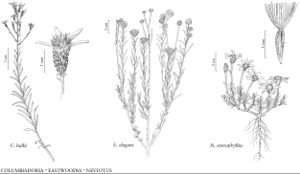Difference between revisions of "Eastwoodia elegans"
Zoë 4: 397, plate 30. 1894.
Common names: Yellow-aster
Treatment appears in FNA Volume 20. Treatment on page 169.
FNA>Volume Importer |
FNA>Volume Importer |
||
| Line 48: | Line 48: | ||
|publication year=1894 | |publication year=1894 | ||
|special status= | |special status= | ||
| − | |source xml=https://jpend@bitbucket.org/aafc-mbb/fna-data-curation.git/src/ | + | |source xml=https://jpend@bitbucket.org/aafc-mbb/fna-data-curation.git/src/f6b125a955440c0872999024f038d74684f65921/coarse_grained_fna_xml/V19-20-21/V20_369.xml |
|tribe=Asteraceae tribe Astereae | |tribe=Asteraceae tribe Astereae | ||
|genus=Eastwoodia | |genus=Eastwoodia | ||
Revision as of 19:42, 24 September 2019
Stems: older with white and shredding bark. Leaves yellow-green, relatively evenly spaced and little reduced in size to immediately proximal to heads, 1.5–4 cm, sometimes in axillary clusters. Cypselae 1.7–2 mm; pappi nearly equal to corollas. 2n = 18.
Phenology: Flowering Apr–Jul.
Habitat: Dry hillsides with other shrubs
Elevation: 60–1300 m
Discussion
Eastwoodia elegans grows in the coast ranges from the San Francisco region to Santa Barbara and Kern counties.
Selected References
None.
Lower Taxa
None.

